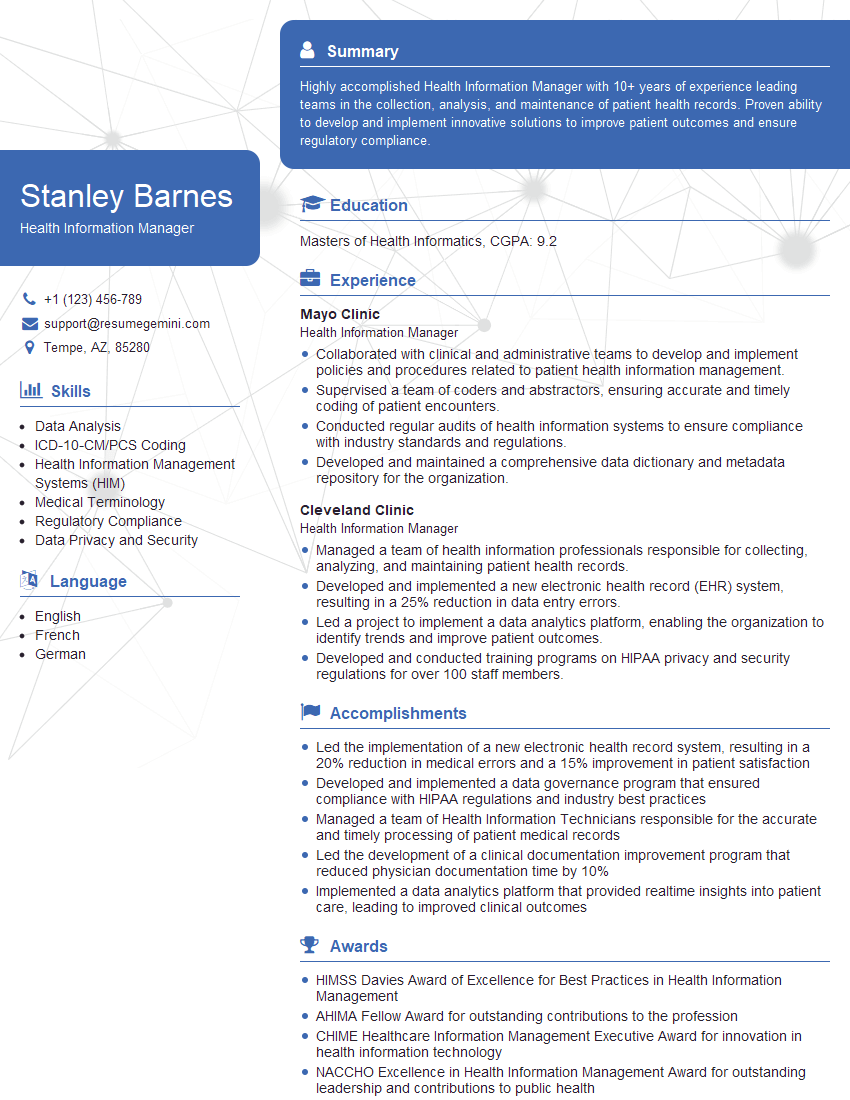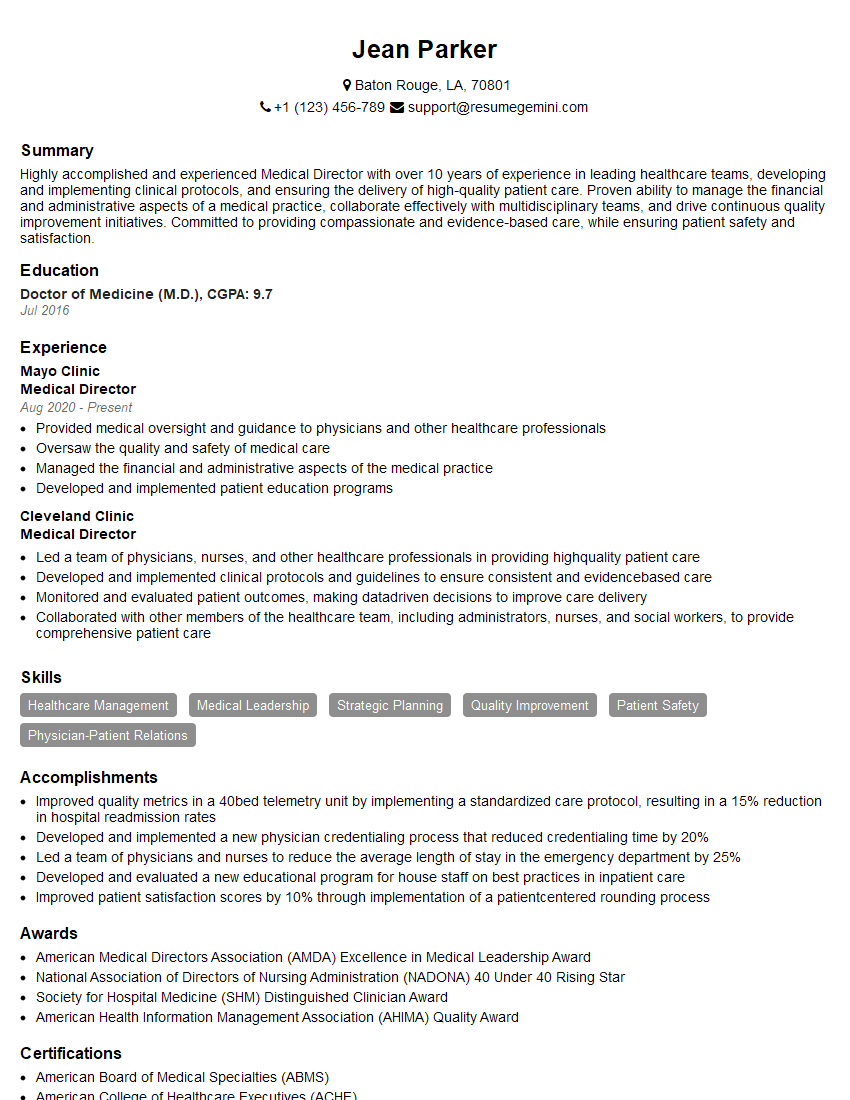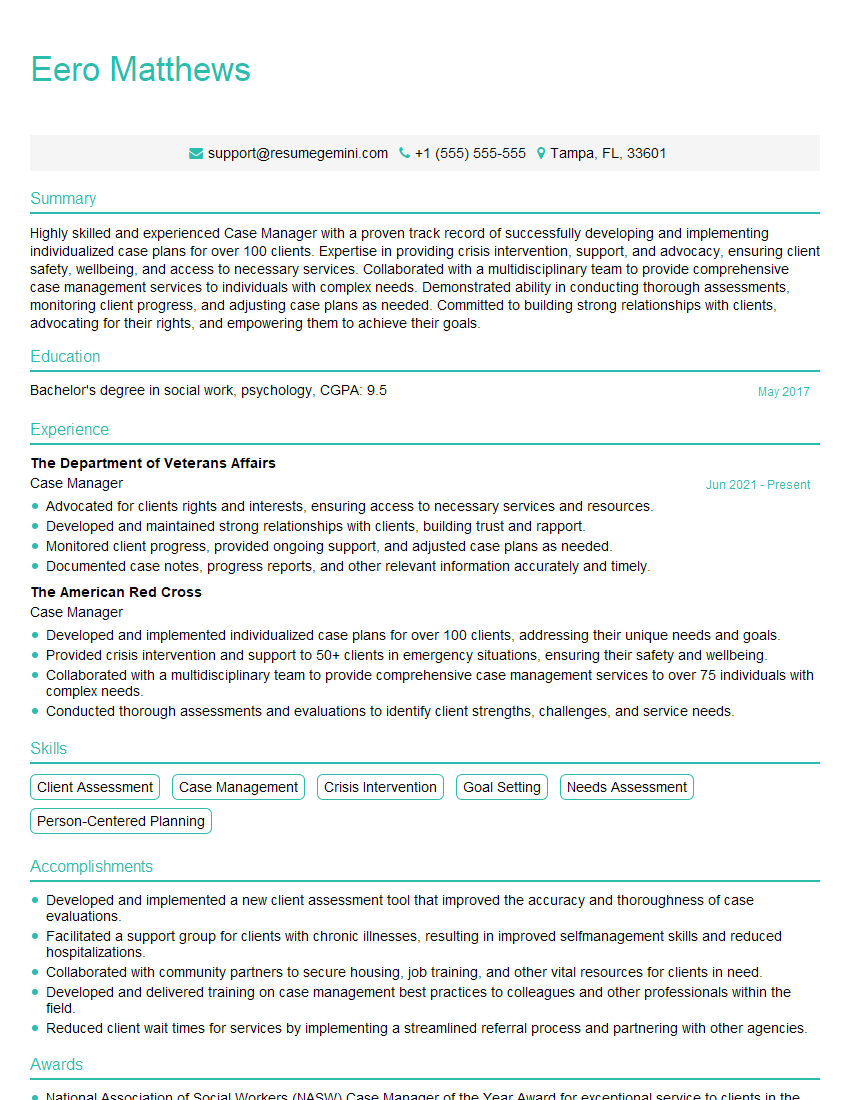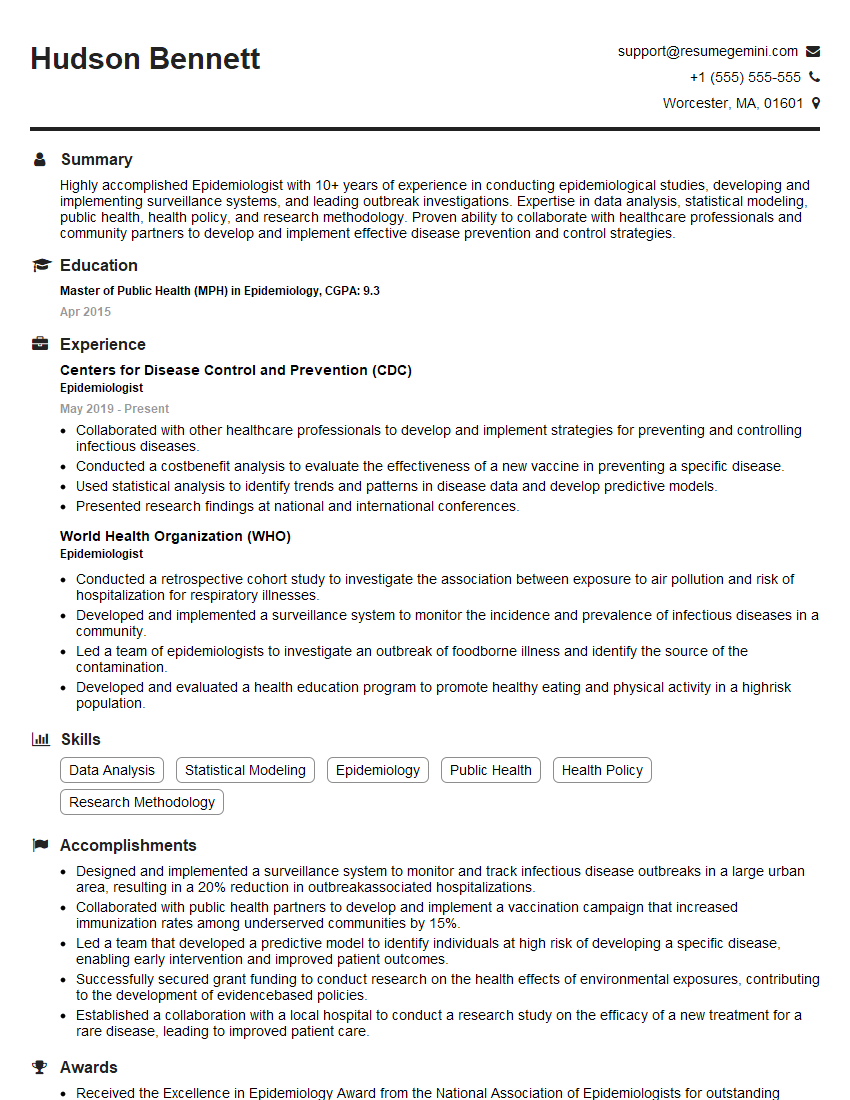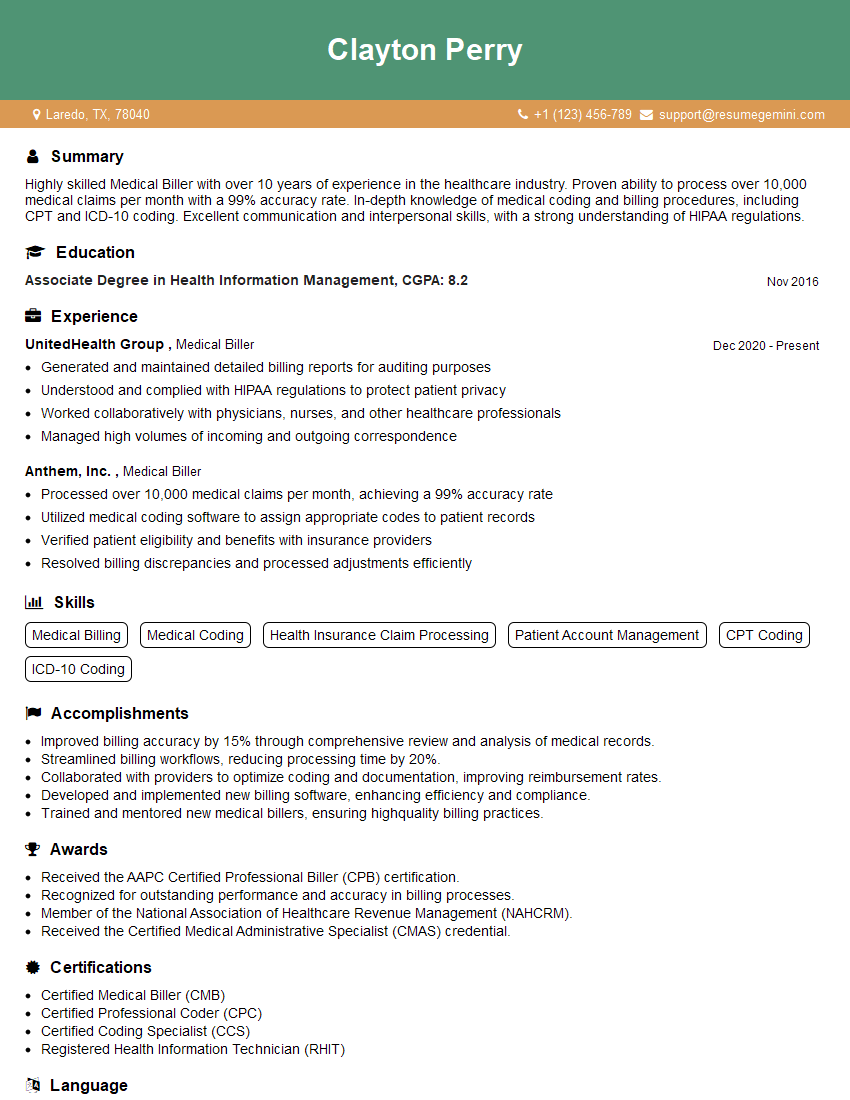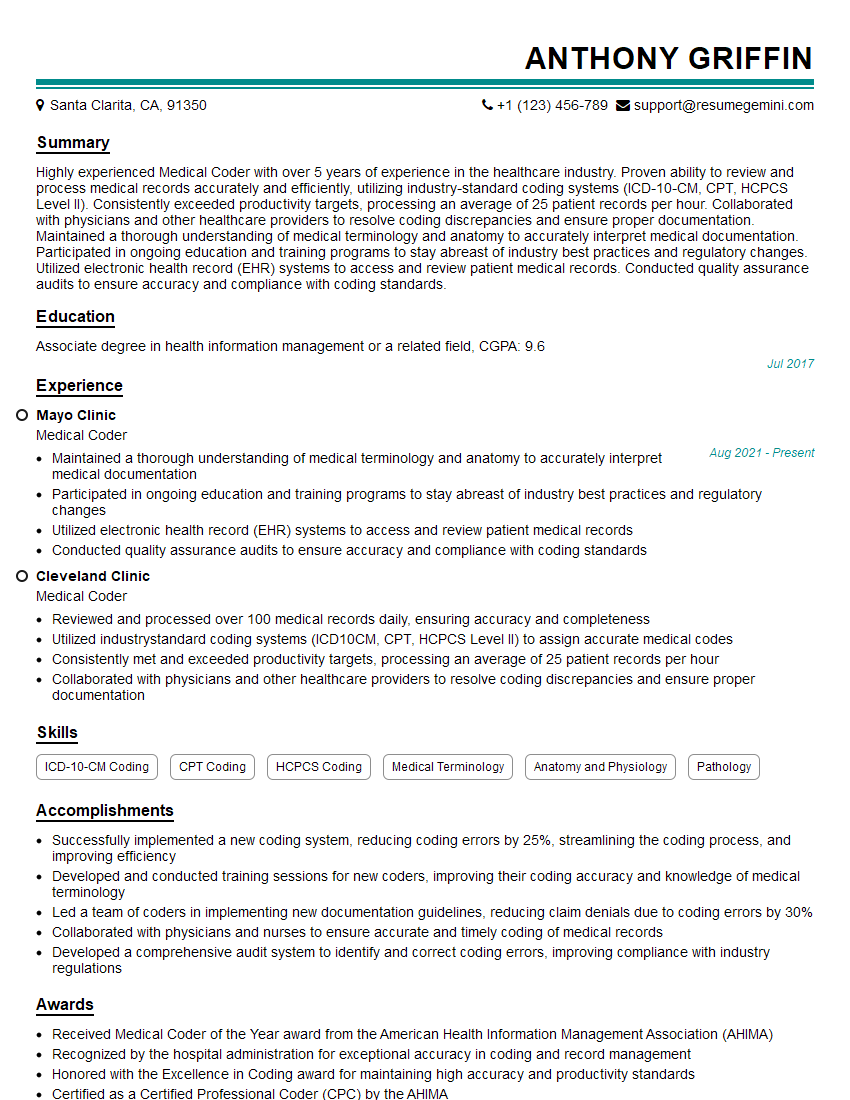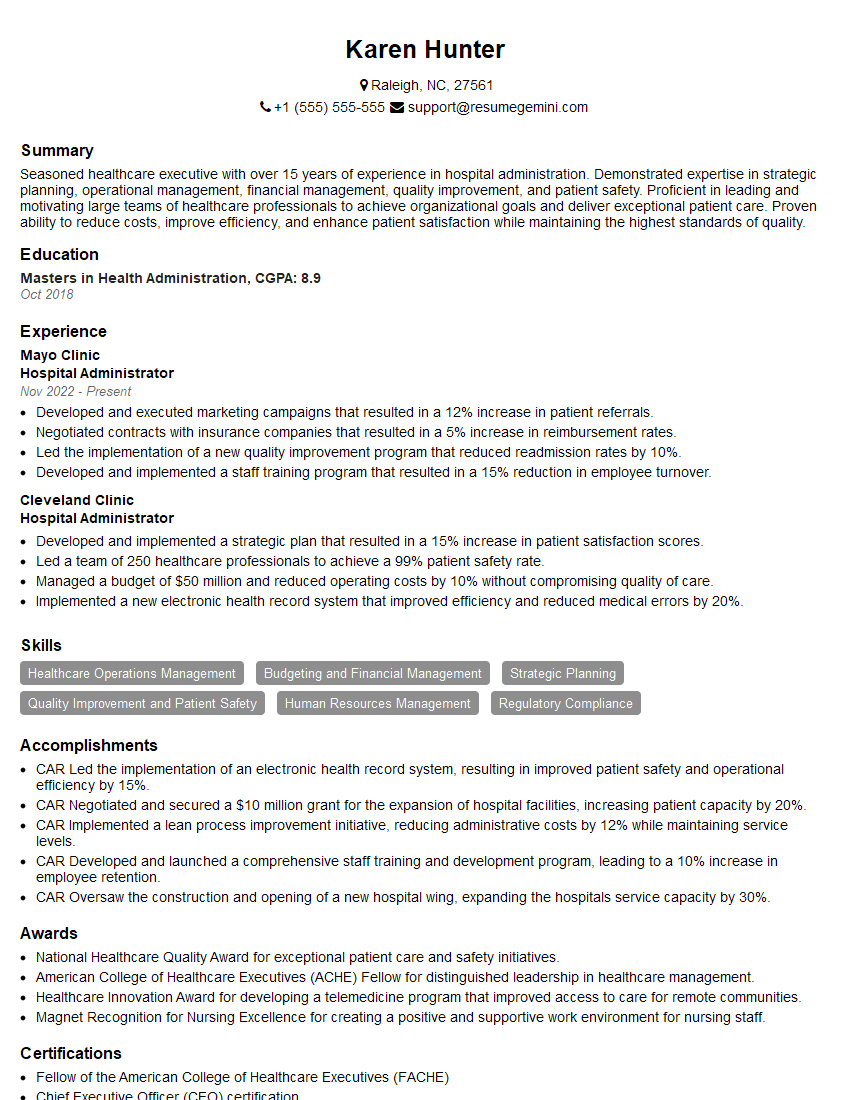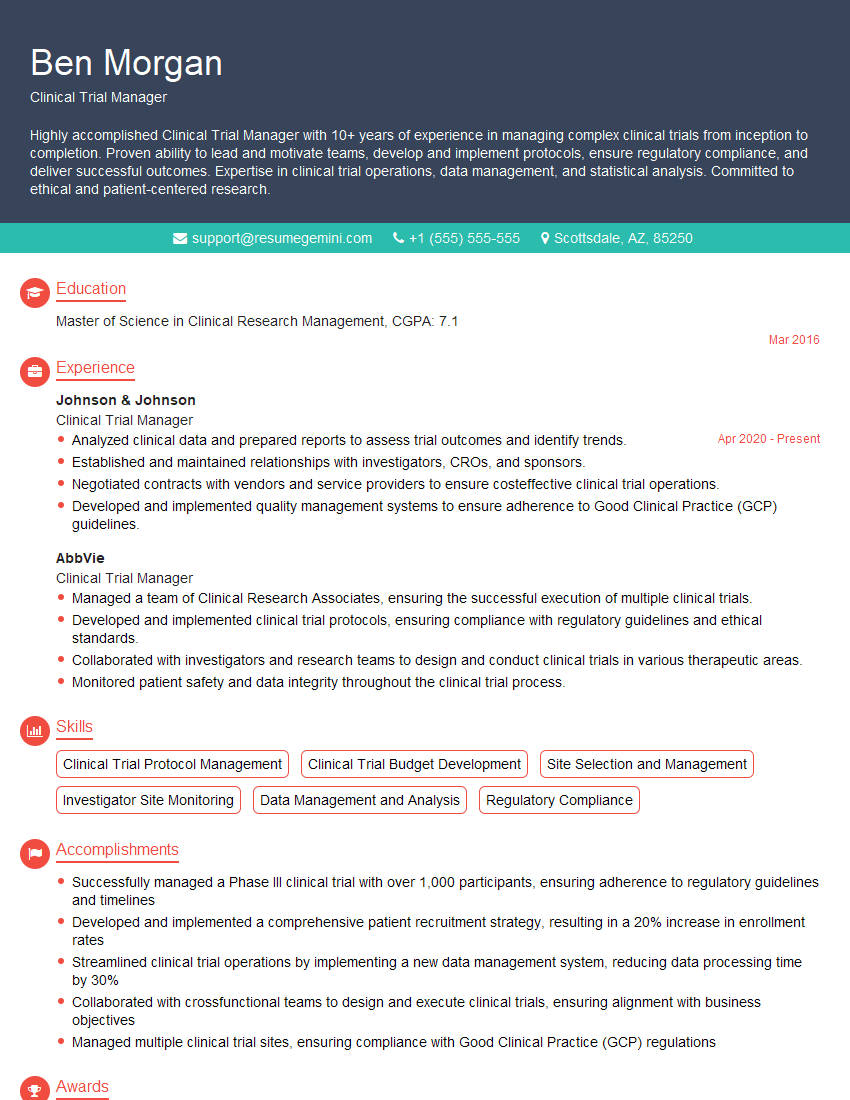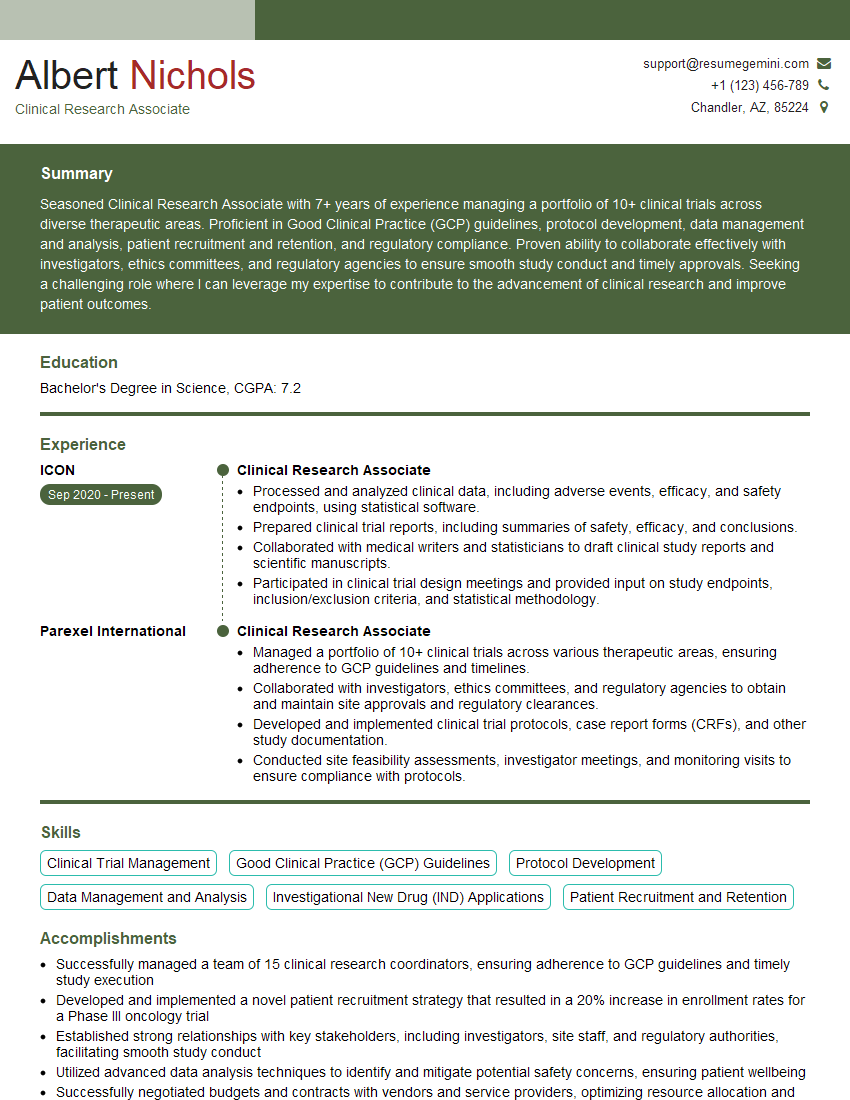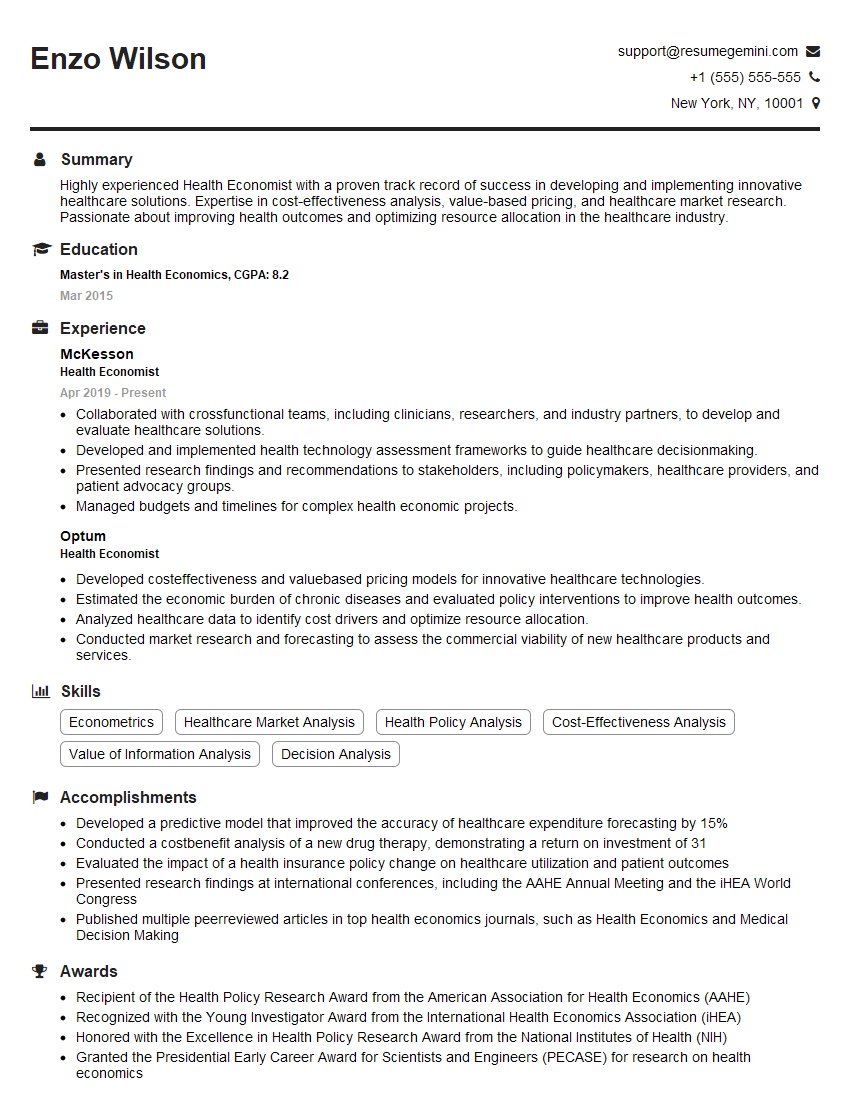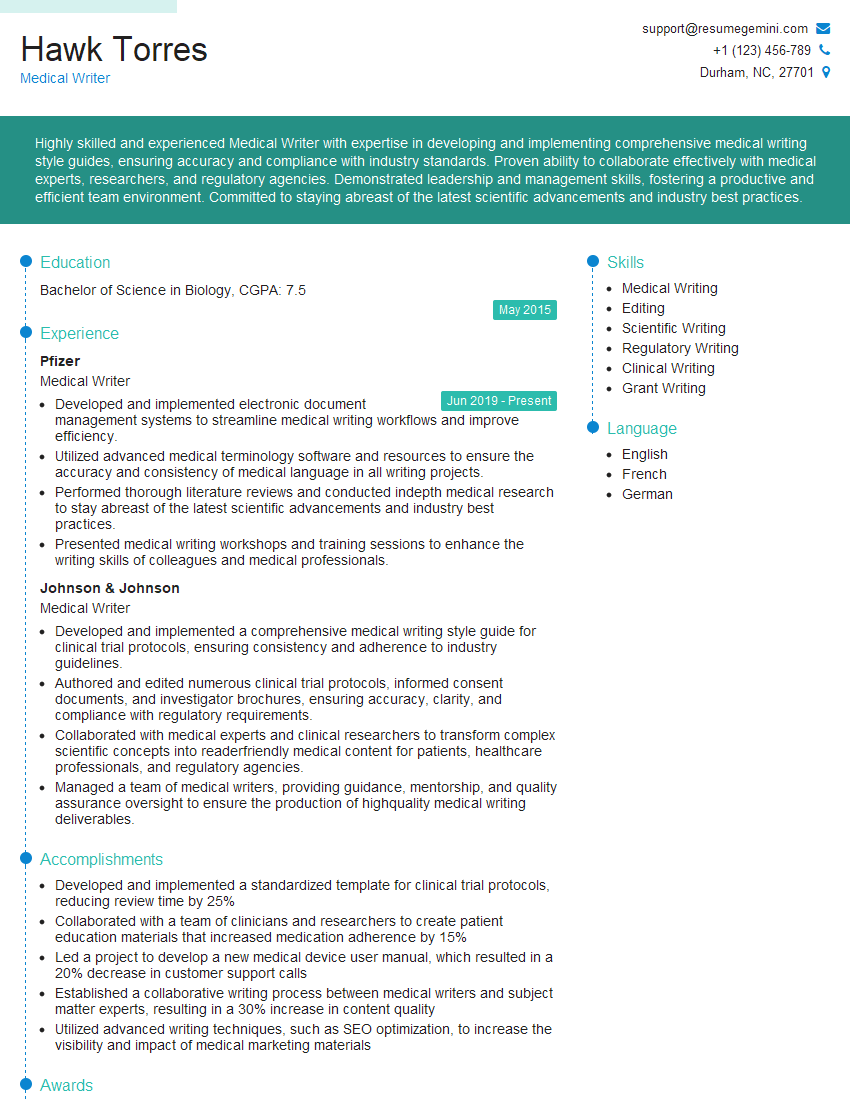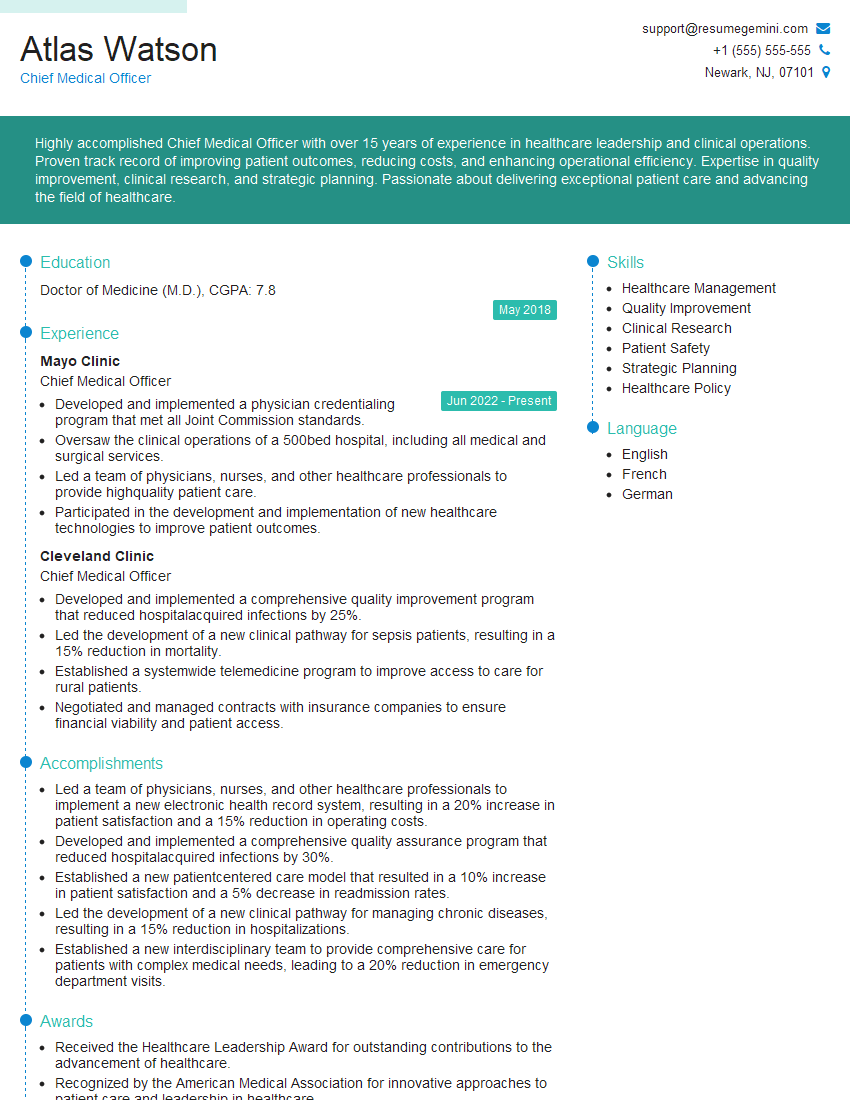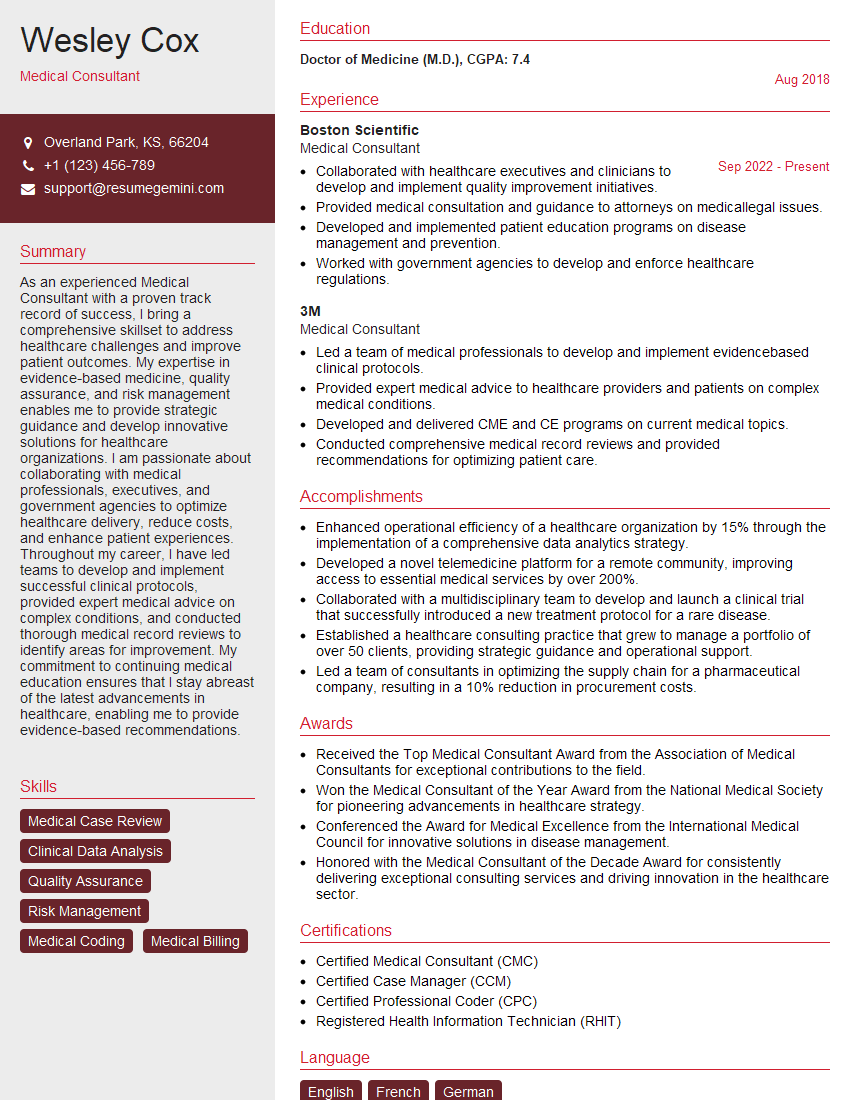The right preparation can turn an interview into an opportunity to showcase your expertise. This guide to Medical Decision-making interview questions is your ultimate resource, providing key insights and tips to help you ace your responses and stand out as a top candidate.
Questions Asked in Medical Decision-making Interview
Q 1. Describe your approach to evaluating diagnostic test results in the context of patient history and clinical findings.
Evaluating diagnostic test results requires a holistic approach, integrating the test’s sensitivity and specificity with the patient’s clinical presentation and prior probability of disease. It’s not just about the number; it’s about the context.
My approach involves several steps:
- Reviewing the Patient’s History: This includes their age, gender, relevant medical history, current symptoms, and any risk factors. For example, a 60-year-old smoker presenting with a persistent cough has a higher pre-test probability for lung cancer than a 20-year-old non-smoker with the same symptom.
- Analyzing Clinical Findings: This includes physical examination results, previous investigations, and any other relevant clinical data. A positive chest X-ray, for instance, strengthens the suspicion of lung cancer.
- Interpreting Test Results: I consider the test’s sensitivity (ability to correctly identify those with the disease) and specificity (ability to correctly identify those without the disease). A highly sensitive test will rarely miss a case of the disease, whereas a highly specific test will rarely produce a false positive. Understanding these characteristics is crucial in interpreting the result in light of the pre-test probability.
- Calculating Post-test Probability: This step often involves using Bayes’ theorem (more on this later), mentally or using a calculator, to quantify the likelihood of disease after considering the test result and pre-test probability. This helps in determining the next steps, such as further investigations or treatment.
- Clinical Judgement: Finally, I combine all this information with my clinical judgment and experience to reach a diagnosis and develop a management plan. This is often an iterative process, where new data may lead to reevaluation and adjustment of the initial assessment.
For instance, a slightly elevated PSA (Prostate-Specific Antigen) in a 70-year-old man might not warrant immediate biopsy, but the same result in a 40-year-old man would warrant further investigation due to the lower pre-test probability of prostate cancer in older men.
Q 2. Explain how you would utilize evidence-based guidelines to make clinical decisions in a complex case.
Evidence-based guidelines are crucial for making sound clinical decisions. They represent the best available evidence synthesized from rigorous research. My approach involves a structured process:
- Identify the relevant guidelines: I start by identifying the relevant clinical guidelines from reputable sources such as the National Institutes of Health (NIH), Cochrane Library, or professional medical organizations. The specific guideline will depend on the patient’s condition and the clinical question.
- Assess the quality of the evidence: Guidelines aren’t created equally. I assess the strength of evidence supporting the recommendations. High-quality evidence, often from randomized controlled trials, carries more weight. I also consider the grade of recommendation (e.g., strong, weak) provided in the guideline.
- Apply the guidelines to the individual patient: Guidelines provide general recommendations but must be tailored to the specific patient’s clinical context. Factors such as age, comorbidities, and individual preferences are carefully considered.
- Document the rationale: It is crucial to clearly document the rationale for the clinical decision, including the specific guidelines used, any deviations from the guidelines, and the justification for those deviations. This ensures transparency and allows for easier peer review and potential auditing.
- Stay updated: Guidelines are periodically updated as new research emerges. I actively monitor for updates and incorporate them into my practice.
For example, in managing hypertension, I would refer to guidelines from organizations like the American Heart Association or the National Institute of Health. These guidelines provide evidence-based recommendations on target blood pressure, lifestyle modifications, and medication choices. However, I would adjust the treatment approach depending on the patient’s specific risk factors and comorbidities.
Q 3. How do you incorporate patient preferences and values into your decision-making process?
Shared decision-making is central to my approach. It acknowledges that medical decisions are not solely the purview of the physician, but rather a collaborative effort between the physician and the patient. I strive to understand and respect the patient’s preferences and values while providing them with the best available medical information.
This is achieved through:
- Open Communication: I foster open dialogue with patients, explaining their condition in clear, understandable terms, along with the various treatment options, benefits, risks, and potential side effects. I use visual aids or simple analogies if needed.
- Active Listening: I actively listen to the patient’s concerns, questions, and preferences. I ensure that they understand their options and the potential consequences of each choice.
- Shared Decision-Making Tools: In complex cases, I may utilize shared decision-making tools, such as decision aids or questionnaires. These tools present information in a structured way, helping patients to clarify their preferences.
- Respecting Patient Autonomy: Ultimately, I respect the patient’s right to make their own decisions, even if they choose an option I might not personally recommend, as long as it’s informed and aligned with their values. My role is to provide them with the knowledge and support they need to make an informed decision.
For example, when discussing treatment options for breast cancer, I will not only explain the surgical, radiation, and chemotherapy options but also explore the patient’s priorities – is it life extension, symptom control, or preserving quality of life that matters most? This shapes our shared decision and creates a more tailored plan.
Q 4. Describe a situation where you had to make a difficult clinical decision under time pressure. What was your approach?
One instance involved a patient presenting to the emergency room with acute shortness of breath and chest pain, suggestive of a possible pulmonary embolism (PE). Time was critical as delayed diagnosis and treatment could have life-threatening consequences.
My approach was methodical but rapid:
- Rapid Assessment: I quickly assessed the patient’s vital signs, reviewed their medical history (focussing on risk factors for PE), and conducted a focused physical exam.
- Prioritization: I prioritized tests based on likelihood of providing crucial information quickly. A D-dimer test was ordered immediately as it could help rule out a PE fairly quickly if negative. Simultaneously, I initiated supportive measures like oxygen therapy to improve oxygenation.
- Parallel Processing: While awaiting test results, I communicated my concerns to the radiology department to expedite a CT pulmonary angiogram (CTPA), the gold standard for diagnosing PE. I also sought consultation with a pulmonologist for expert opinion.
- Decision-Making Under Uncertainty: The D-dimer came back positive. This was non-specific but increased my concern. Before the CTPA results were back, I had to make a crucial decision based on the probability of a PE given the overall clinical picture. Given the high risk of a PE based on presentation, I initiated anticoagulation therapy while awaiting the CTPA results. This decision, although made under uncertainty, was deemed necessary due to the urgency and risk of delay.
- Post-Intervention Review: The CTPA ultimately confirmed the diagnosis of a PE. Post-incident, I documented everything meticulously and reviewed my approach. This helped to identify areas for improvement for faster response in similar scenarios.
Q 5. How do you evaluate the risk-benefit ratio of various treatment options?
Evaluating the risk-benefit ratio is paramount in medical decision-making. It requires a careful weighing of the potential benefits of a treatment against its potential risks and side effects.
My process involves:
- Identifying Potential Benefits: I clearly define the potential benefits of each treatment option. For example, increased life expectancy, improved quality of life, symptom relief, or disease remission. The magnitude and likelihood of each benefit need to be considered.
- Identifying Potential Risks: I systematically identify and assess the potential risks and side effects associated with each treatment option. This may include adverse events, complications, or long-term effects. The likelihood and severity of each risk are important.
- Quantifying Risks and Benefits: When possible, I try to quantify the risks and benefits using numerical data from clinical trials or other research. This may involve calculating absolute risk reduction, number needed to treat (NNT), or other relevant metrics.
- Considering Patient-Specific Factors: The risk-benefit profile may vary significantly from one patient to another. Factors like age, comorbidities, and personal preferences are crucial in determining the relative importance of different risks and benefits for a specific patient.
- Shared Decision-Making: I engage in shared decision-making with the patient, presenting the risks and benefits in a transparent and understandable way. This allows the patient to make an informed choice aligned with their values and preferences.
For example, in deciding between surgery and radiation for a certain type of cancer, I would analyze the success rates, survival rates, and potential complications of each approach for this specific patient before discussing it with them to weigh the potential harms against potential gains.
Q 6. Explain your understanding of Bayesian reasoning and how it applies to medical diagnosis.
Bayesian reasoning is a powerful framework for updating our beliefs in the face of new evidence. It’s particularly relevant in medical diagnosis where we start with a prior probability (pre-test probability) of a disease and update this probability based on new information, such as test results or clinical findings.
In essence, Bayes’ theorem allows us to calculate the posterior probability (post-test probability) of disease, which is the probability of having the disease after considering new evidence:
P(Disease|Evidence) = [P(Evidence|Disease) * P(Disease)] / P(Evidence)
Where:
P(Disease|Evidence)is the posterior probability (what we want to find).P(Evidence|Disease)is the likelihood of observing the evidence given the disease is present (related to test sensitivity and specificity).P(Disease)is the prior probability (pre-test probability).P(Evidence)is the probability of observing the evidence (can be complex to calculate directly, often simplified with other approaches).
Let’s say we suspect a patient has a particular condition that has a 10% prior probability (P(Disease) = 0.1). A diagnostic test has a sensitivity of 90% and specificity of 80%. If the test result is positive, we use Bayes’ theorem to calculate the probability of disease given a positive test result. The exact calculation will depend on the prevalence of the disease in the population (which influences P(Evidence)).
Bayesian reasoning helps us make more informed decisions by moving beyond simple interpretations of test results and incorporating all relevant information to form a more accurate estimate of the probability of disease. It is especially valuable when dealing with imperfect diagnostic tests.
Q 7. How familiar are you with different decision-making models (e.g., decision trees, Markov models)?
I am familiar with several decision-making models, including decision trees and Markov models. These models provide a structured and visual way to analyze complex clinical decisions.
- Decision Trees: These are graphical representations of decision-making processes. They show different pathways based on various choices and their potential outcomes. Decision trees are useful for making relatively simple decisions with clear choices and outcomes. For example, a decision tree could help decide whether to perform surgery based on risk factors and the severity of a condition.
- Markov Models: These models are used to simulate dynamic systems that change over time, such as the progression of a chronic disease or the effectiveness of long-term treatment. They depict the probabilities of transitioning between different health states. Markov models are particularly useful for analyzing long-term health outcomes and costs. For example, a Markov model could model the progression of heart failure over many years, showing the probabilities of hospitalizations, disability, or death under different treatment strategies.
While these models can be powerful tools, they also have limitations. They require assumptions about probabilities and outcomes which may not always be accurate. Additionally, it’s crucial to remember that they are tools to aid decision-making, and the final decision should always incorporate clinical judgement and patient-specific factors.
Q 8. How do you identify and mitigate potential biases in your clinical decision-making?
Identifying and mitigating bias in clinical decision-making is crucial for providing equitable and effective care. We all hold unconscious biases, shaped by our experiences and societal influences. Recognizing these biases is the first step. I employ several strategies:
Self-reflection and awareness: Regularly reflecting on my own potential biases – related to age, gender, race, socioeconomic status, etc. – helps me identify areas where my judgments might be skewed.
Structured decision-making tools: Using checklists, algorithms, and clinical pathways reduces reliance on intuition and helps standardize care, minimizing the impact of personal biases. For instance, a structured approach to assessing chest pain ensures I don’t prematurely dismiss symptoms based on a patient’s age or appearance.
Seeking diverse perspectives: I actively involve colleagues and engage in discussions with other healthcare professionals to gain alternative viewpoints and challenge my own assumptions. A second opinion, especially from someone with a different background, can be invaluable in identifying potential biases.
Data-driven decision making: I rely heavily on objective data and evidence-based guidelines to guide my decisions, minimizing the influence of subjective biases. For instance, I use diagnostic testing results, rather than relying on gut feelings, to inform treatment plans.
Continuous learning: Staying abreast of the latest research on bias in healthcare and participating in continuing medical education on implicit bias and cultural competency are essential for ongoing improvement.
For example, I recently encountered a patient with atypical chest pain. My initial inclination was to attribute it to musculoskeletal pain, but a structured approach using the TIMI risk score and further investigation revealed a significant cardiac event that needed immediate intervention. This highlights the importance of mitigating potential biases through a systematic approach.
Q 9. Describe your experience with using clinical decision support systems (CDSS).
Clinical Decision Support Systems (CDSS) have become integral to my practice. I’ve used various CDSS, ranging from simple medication interaction checkers to sophisticated systems providing real-time risk assessments and treatment recommendations. My experience includes:
Improved diagnostic accuracy: CDSS like those incorporating imaging analysis have improved my ability to interpret complex medical images, leading to more accurate diagnoses.
Enhanced treatment planning: Systems providing evidence-based treatment guidelines have assisted in developing tailored treatment plans based on the patient’s specific characteristics and condition. For example, a CDSS helped me optimize the dosage of a medication for a patient with chronic kidney disease, ensuring both efficacy and safety.
Reduced medical errors: CDSS have helped me avoid medication errors by flagging potential drug interactions and contraindications. This is especially useful when managing patients on multiple medications.
Increased efficiency: Automated tasks like order entry and documentation have freed up valuable time, allowing me to focus more on patient interaction and care.
However, it’s crucial to remember that CDSS are tools, not replacements for clinical judgment. I always critically evaluate the recommendations provided by the system, considering the individual patient context and the limitations of the underlying data. Blindly following CDSS recommendations without clinical reasoning can be detrimental.
Q 10. How do you stay current with the latest medical research and guidelines relevant to your area of expertise?
Staying current with medical research and guidelines is paramount for providing optimal patient care. I utilize a multi-pronged approach:
Subscribing to reputable medical journals: I regularly read journals such as the New England Journal of Medicine, The Lancet, and journals specific to my area of expertise to stay updated on cutting-edge research.
Participating in continuing medical education (CME): CME activities, including conferences, workshops, and online courses, offer valuable opportunities to learn about the latest advancements and best practices. I prioritize CME that focuses on evidence-based medicine and critical appraisal of research.
Following professional organizations and societies: Membership in relevant professional organizations provides access to guidelines, updates, and networking opportunities. I actively participate in these societies to stay informed.
Utilizing reputable online resources: Platforms like PubMed, UpToDate, and professional society websites offer reliable access to medical information and guidelines. I critically evaluate the sources I use, considering the author’s expertise and potential conflicts of interest.
Engaging in peer-to-peer learning: Regular discussions with colleagues and attending departmental meetings facilitate the exchange of knowledge and insights.
This combination of formal and informal learning ensures I remain knowledgeable and equipped to provide the most effective and up-to-date care.
Q 11. How would you approach a situation where there’s a conflict between evidence-based medicine and patient preferences?
Conflicts between evidence-based medicine and patient preferences are common in clinical practice. Addressing these situations requires a collaborative and patient-centered approach:
Shared decision-making: I engage in open and honest communication with the patient, explaining the evidence-based recommendations, potential benefits and risks, along with the rationale behind them. I present the options clearly and respectfully, without imposing my own preferences.
Understanding patient values and beliefs: I take the time to understand the patient’s perspective, exploring their concerns, priorities, and preferences. This may involve discussing their cultural background, personal beliefs, and life goals.
Finding common ground: I work collaboratively with the patient to find a treatment plan that aligns with both the evidence-based medicine and the patient’s values and preferences. This may involve exploring alternative options or adjusting the treatment plan to better suit the patient’s needs and circumstances. Compromise is often key.
Documentation: I meticulously document the discussion, the patient’s preferences, the rationale for the chosen treatment plan (even if it deviates from strict guidelines), and any shared decision-making process involved. This protects both the patient and the healthcare provider.
For instance, a patient might refuse chemotherapy despite strong evidence supporting its efficacy due to concerns about side effects. Through open communication, we explored alternative treatment options and developed a plan that prioritized minimizing side effects while maintaining a reasonable chance of positive outcomes. The key is respectful dialogue and a collaborative approach.
Q 12. Describe your approach to dealing with uncertainty in medical decision-making.
Uncertainty is inherent in medicine. My approach to dealing with uncertainty involves:
Acknowledging the uncertainty: I openly communicate the uncertainties associated with a diagnosis or treatment plan with the patient, avoiding the illusion of certainty. Honesty builds trust.
Utilizing diagnostic and prognostic tools: I leverage appropriate diagnostic tests and utilize established prognostic models to gain a clearer picture of the situation, even if it doesn’t eliminate all uncertainty. This may include ordering additional investigations or seeking a second opinion.
Employing Bayesian reasoning: I update my clinical judgment as new information becomes available, adjusting my probability assessments based on evidence. This iterative process helps refine my approach as more data emerge.
Implementing a plan that considers uncertainty: I develop a treatment plan that is adaptable and flexible, allowing for adjustments as new information becomes available or the patient’s condition changes. This approach involves regular monitoring and reassessment.
Seeking expert consultation: When faced with significant uncertainty or complex cases, I don’t hesitate to consult specialists or experts in the relevant field to gain additional perspectives and expertise.
For example, when faced with a rare disease presentation, I may need to rely on literature reviews, expert opinions, and potentially participate in multidisciplinary discussions before establishing a treatment plan.
Q 13. How do you assess the reliability and validity of medical information sources?
Assessing the reliability and validity of medical information sources is critical for evidence-based practice. My approach focuses on:
Source evaluation: I assess the credibility of the source by considering the author’s expertise, potential conflicts of interest, and the publication’s reputation (e.g., peer-reviewed journals vs. blogs).
Methodology scrutiny: For research articles, I scrutinize the study design, sample size, statistical methods, and potential biases to assess the validity and reliability of the findings. I am particularly cautious of observational studies and rely more heavily on randomized controlled trials (RCTs) where appropriate.
Date of publication: I pay close attention to the date of publication, recognizing that medical knowledge is constantly evolving, and older information may be outdated or superseded.
Cross-referencing information: I don’t rely on a single source. I cross-reference information from multiple credible sources to ensure consistency and identify potential discrepancies or biases.
Level of evidence: I understand the hierarchy of evidence (e.g., systematic reviews, meta-analyses, RCTs, cohort studies, case-control studies, case reports) and prioritize higher-level evidence in my decision-making process.
For instance, I would be more cautious about information from a commercial website compared to a meta-analysis published in a peer-reviewed journal.
Q 14. Explain how you would prioritize patient needs when facing resource constraints.
Prioritizing patient needs under resource constraints requires a thoughtful and ethical approach. My strategy involves:
Needs assessment: I carefully assess the urgency and severity of each patient’s needs, considering factors such as life-threatening conditions, potential for long-term disability, and quality of life.
Triaging patients: I prioritize patients based on the urgency of their needs, allocating resources to those with the most critical conditions first. This often involves using established triage systems and guidelines.
Resource optimization: I strive to optimize the use of available resources, such as medications, procedures, and staffing, ensuring efficient allocation without compromising patient safety or quality of care.
Ethical considerations: I adhere to ethical guidelines, ensuring fair and equitable distribution of resources, considering factors such as age, gender, race, and socioeconomic status should not influence the prioritization of care.
Communication and transparency: I communicate openly and transparently with patients and their families about resource limitations and the rationale behind the prioritization decisions, providing reassurance and support.
For example, in a situation with limited ventilators, I would prioritize patients with the highest likelihood of survival and the greatest potential for recovery, balancing this with the ethical considerations ensuring equitable allocation.
Q 15. Describe your experience in collaborating with other healthcare professionals to reach a shared clinical decision.
Effective collaboration is the cornerstone of safe and efficient healthcare. In my experience, reaching shared clinical decisions involves a multi-step process emphasizing open communication, mutual respect, and evidence-based reasoning. I’ve worked extensively in interdisciplinary teams, including physicians, nurses, pharmacists, and physiotherapists. For example, in a recent case involving a patient with complex diabetes management, we utilized a structured approach. First, we gathered comprehensive patient data, then each team member presented their perspective on the patient’s condition and treatment plan. This was followed by a discussion to identify potential risks and benefits of different approaches, weighing evidence from clinical guidelines and research literature. Finally, we collaboratively developed a personalized treatment plan, ensuring consensus and clear roles for each member of the team. This process involves active listening, respectful debate, and a willingness to compromise, ultimately resulting in a holistic and optimal treatment strategy. The key is to create a safe space for all voices to be heard, ensuring the patient’s best interests remain central to our decisions.
Career Expert Tips:
- Ace those interviews! Prepare effectively by reviewing the Top 50 Most Common Interview Questions on ResumeGemini.
- Navigate your job search with confidence! Explore a wide range of Career Tips on ResumeGemini. Learn about common challenges and recommendations to overcome them.
- Craft the perfect resume! Master the Art of Resume Writing with ResumeGemini’s guide. Showcase your unique qualifications and achievements effectively.
- Don’t miss out on holiday savings! Build your dream resume with ResumeGemini’s ATS optimized templates.
Q 16. How do you handle errors in medical decision-making? What steps do you take to learn from mistakes?
Medical errors are inevitable, but how we respond to them defines our professional integrity and commitment to patient safety. My approach focuses on a structured, non-punitive process of reflection and learning. The first step involves thoroughly investigating the error, identifying contributing factors without placing blame. This often involves analyzing medical records, interviewing involved personnel, and reviewing relevant guidelines and protocols. Next, I use this analysis to develop an action plan targeting specific areas for improvement. This may involve refining protocols, enhancing training programs, or implementing new technologies to prevent similar errors. Critical to this process is transparent communication with the patient and their family, addressing concerns and ensuring they understand the steps taken to rectify the situation and prevent future recurrence. Finally, documentation of the error, investigation, and corrective actions is vital for continuous quality improvement. For instance, if a medication error occurred due to illegible handwriting on a prescription, our team would implement a policy change requiring electronic prescribing. This systematic approach helps us learn from mistakes, not just to avoid repeating them, but also to strengthen our systems and ultimately improve patient care.
Q 17. Explain your understanding of shared decision-making and its importance in patient care.
Shared decision-making (SDM) is a collaborative approach where clinicians and patients work together to make healthcare decisions. It’s not about the clinician imposing their expertise, but rather a partnership built on mutual respect, where the patient’s values, preferences, and goals guide the choices. SDM is crucial for improving patient outcomes and satisfaction. Think of it like this: A patient might have several treatment options for a condition. Through SDM, we present the options clearly, discuss the potential benefits, risks, and uncertainties of each, and help the patient understand their implications. The clinician provides evidence-based information, but the final decision rests with the patient. This approach empowers patients, leading to improved adherence to treatment plans and greater satisfaction with care. For example, when discussing cancer treatment options, we’ll present the scientific evidence for each treatment, along with the potential side effects and quality of life implications. Through open dialogue, we help the patient select the option that best aligns with their personal priorities. The value of SDM extends beyond individual patient experiences, contributing to a more equitable and patient-centered healthcare system.
Q 18. How do you communicate complex medical information to patients and their families in a clear and understandable way?
Communicating complex medical information requires careful planning and empathy. I use the “teach-back” method, where I explain the information in simple terms, using analogies and avoiding jargon whenever possible, and then ask the patient to explain it back to me in their own words. This confirms their understanding and allows for clarification. I also use visual aids like diagrams or charts, and tailor my communication style to the patient’s individual needs and preferences. For families, I ensure everyone has an opportunity to ask questions and address concerns. I find that actively listening to their questions and anxieties is key to building trust and fostering a collaborative relationship. For instance, when explaining a complicated diagnosis, I might use a simple analogy, like comparing the body to a car, to help patients grasp the concept. Building rapport and using plain language, visual aids, and the teach-back method ensures effective communication and minimizes patient confusion and anxiety.
Q 19. How do you use data analytics to inform clinical decision-making?
Data analytics plays a transformative role in modern healthcare, enhancing our ability to make informed clinical decisions. I utilize large datasets – including electronic health records, claims data, and clinical trial results – to identify trends, patterns, and insights relevant to patient care. For example, analyzing patient demographics and medical history data can help us identify high-risk individuals who might benefit from preventative interventions. We can also track the effectiveness of different treatments by analyzing patient outcomes, allowing us to tailor care to individual needs and optimize treatment strategies. This data-driven approach improves efficiency, resource allocation, and overall patient outcomes. Furthermore, analyzing population-level data can identify disparities in healthcare access and quality, enabling us to advocate for targeted interventions and equitable resource distribution. Essentially, data analytics allows us to move from reactive to proactive healthcare, improving efficiency and care quality.
Q 20. Describe your experience using predictive analytics or machine learning in healthcare.
Predictive analytics and machine learning offer exciting opportunities to improve healthcare decision-making. I have experience using algorithms to predict patient risks, such as the likelihood of readmission after a hospital stay, or the probability of developing certain complications. This information allows us to proactively implement interventions to mitigate these risks. For instance, using machine learning models trained on large datasets of patient records, we can identify individuals at high risk for heart failure and offer targeted preventive strategies. These tools can also personalize treatment by predicting which therapies will be most effective for individual patients. While these technologies offer immense potential, it is crucial to use them ethically and responsibly, ensuring data privacy and addressing potential biases within the algorithms. Transparency and careful validation are key to responsible implementation.
Q 21. What are some common pitfalls in medical decision-making and how can they be avoided?
Several pitfalls can hinder effective medical decision-making. One common issue is cognitive bias, such as confirmation bias (favoring information confirming pre-existing beliefs) or anchoring bias (over-relying on initial information). Another is overconfidence, leading to insufficient consideration of alternative diagnoses or treatment options. Information overload and time constraints also pose significant challenges. To avoid these pitfalls, we need a structured approach: actively seeking diverse perspectives, utilizing decision-support tools (like clinical guidelines and decision aids), and engaging in critical self-reflection. Employing checklists and standardized protocols can reduce errors stemming from cognitive overload. Furthermore, fostering a culture of open communication and feedback within healthcare teams helps to identify and address potential biases. A multidisciplinary approach, involving various specialists, ensures a comprehensive review of the case, minimizing the risk of relying on limited perspectives. Ultimately, a commitment to continuous learning and self-improvement is critical to mitigating these common pitfalls in medical decision-making.
Q 22. How do you approach ethical dilemmas related to medical decision-making?
Ethical dilemmas in medical decision-making are unavoidable. My approach involves a structured process: First, I clearly identify the ethical conflict, specifying the values in tension (e.g., patient autonomy vs. beneficence). Then, I gather all relevant information, including the patient’s preferences, medical facts, and legal considerations. Next, I consult relevant ethical guidelines and resources, such as professional codes of conduct and institutional ethics committees. Crucially, I engage in thoughtful deliberation, considering different perspectives and potential consequences of each course of action. This involves considering the principles of autonomy, beneficence, non-maleficence, and justice. Finally, I document the decision-making process, the rationale behind my chosen course of action, and any dissenting opinions, ensuring transparency and accountability. For instance, if faced with a decision regarding end-of-life care where the patient lacks capacity to communicate their wishes, I’d meticulously explore advance directives, consult family members (within legal boundaries), and seek guidance from an ethics consultant to ensure the decision aligns with the patient’s best interests and respects their values to the extent possible.
Q 23. Describe a situation where you had to defend a clinical decision to a colleague or supervisor.
I once defended my decision to prescribe a less expensive but equally effective medication to a patient. My colleague argued for a newer, more expensive drug, citing marketing materials. I presented evidence-based research demonstrating comparable efficacy and safety between the two medications, highlighting the cost implications for the patient and the healthcare system. Furthermore, I discussed the patient’s financial constraints and how the cost difference could significantly impact their adherence to the treatment plan. By focusing on the patient’s best interests—both clinically and economically—and providing concrete data to support my decision, I was able to persuade my colleague and ultimately, the patient benefitted from a financially feasible, effective treatment.
Q 24. How do you approach diagnostic reasoning in cases with atypical presentations?
Atypical presentations pose a significant challenge. My approach involves a systematic process: I begin by carefully reviewing the patient’s complete history, including social determinants of health, which can often shed light on seemingly unrelated symptoms. I then perform a thorough physical examination, paying attention to subtle details often overlooked. I utilize diagnostic tests strategically, starting with the most sensitive and specific tests based on the most likely diagnoses. This helps to avoid unnecessary tests and costs. I integrate clinical reasoning, considering differential diagnoses, and leverage available resources like clinical decision support systems and literature reviews to investigate less common possibilities. For instance, when a patient presents with chest pain atypical of a heart attack, I consider a wide range of possibilities, from musculoskeletal issues to esophageal problems, and utilize cardiac enzyme tests, EKG, and potentially other imaging as appropriate to arrive at the correct diagnosis.
Q 25. How do you utilize cost-effectiveness analysis in your decision-making?
Cost-effectiveness analysis is crucial in resource allocation. I use it to compare the costs and health outcomes of different interventions, helping to ensure that resources are used judiciously. This involves identifying all relevant costs (direct medical costs, indirect costs such as lost productivity, and intangible costs like pain and suffering), and measuring the health outcomes using metrics like life-years saved or quality-adjusted life-years. I then calculate the cost per unit of health outcome (e.g., cost per life-year saved). This analysis helps to inform decisions about which treatments or interventions to offer, considering not only clinical effectiveness but also value for money. For example, when considering different treatment options for hypertension, I’d compare the costs and effectiveness of various medications to identify the most cost-effective approach that achieves optimal patient outcomes.
Q 26. Explain your understanding of the principles of medical ethics as they relate to decision-making.
Medical ethics principles guide my decision-making. Autonomy respects the patient’s right to make their own informed decisions; Beneficence requires me to act in the patient’s best interest; Non-maleficence mandates minimizing harm; and Justice ensures fair and equitable distribution of healthcare resources. These principles often interact, creating complex ethical dilemmas. For example, a patient’s autonomy to refuse treatment might conflict with the physician’s duty of beneficence to provide potentially life-saving care. In such cases, I strive to balance these principles through careful communication, shared decision-making, and consideration of the patient’s values and preferences.
Q 27. How do you stay updated on changes in healthcare regulations and policies that may affect your decisions?
Staying updated is paramount. I subscribe to relevant professional journals (e.g., the New England Journal of Medicine, JAMA), attend continuing medical education (CME) courses, and actively participate in professional organizations. I also monitor changes on regulatory websites (like the FDA and CMS) and rely on reputable news sources and professional updates to keep abreast of evolving guidelines and policies. Regular engagement with colleagues and participation in case discussions ensures I remain informed and can readily apply new knowledge to my decision-making.
Q 28. Describe your experience working within a quality improvement framework for medical decision-making.
I’ve been involved in several quality improvement (QI) initiatives focused on enhancing medical decision-making. One example involved implementing a standardized order set for managing pneumonia, aiming to reduce variability in care and improve outcomes. The process involved data collection to identify areas for improvement, the development and implementation of the new order set, and continuous monitoring of key performance indicators (KPIs) like length of stay and readmission rates. Through these QI activities, we were able to reduce the average length of stay for pneumonia patients by 15% and decrease the 30-day readmission rate by 10%, demonstrating the positive impact of a structured approach to clinical decision-making within a QI framework. This experience has highlighted the importance of systematic data analysis, collaborative teamwork, and continuous monitoring in optimizing medical care.
Key Topics to Learn for Medical Decision-Making Interview
- Clinical Reasoning and Diagnostic Accuracy: Understanding the process of formulating differential diagnoses, interpreting diagnostic tests, and integrating patient information to arrive at accurate conclusions. Consider the role of bias and cognitive heuristics in the process.
- Evidence-Based Medicine (EBM): Applying the principles of EBM to evaluate the quality of medical literature, critically appraise research findings, and integrate the best available evidence into clinical practice. Practice interpreting statistical data relevant to clinical decisions.
- Risk Assessment and Probability: Calculating and interpreting probabilities, understanding sensitivity and specificity of diagnostic tests, and assessing the risks and benefits of different treatment options. This includes understanding Bayesian reasoning in a clinical context.
- Shared Decision-Making and Patient Communication: Mastering techniques for effectively communicating complex medical information to patients, understanding patient preferences and values, and engaging in collaborative decision-making. Discuss ethical considerations.
- Ethical Considerations in Medical Decision-Making: Exploring ethical frameworks relevant to medical decisions, including autonomy, beneficence, non-maleficence, and justice. Prepare to discuss challenging ethical dilemmas in a medical setting.
- Healthcare Systems and Resource Allocation: Understanding the constraints and limitations within healthcare systems and how these factors influence medical decision-making. Discuss cost-effectiveness and resource allocation strategies.
- Technological Advancements and their Impact: Discuss how technological advancements (AI, telemedicine, etc.) influence clinical decision-making processes and the associated challenges.
Next Steps
Mastering medical decision-making is crucial for career advancement in healthcare. A strong understanding of these principles demonstrates critical thinking, clinical judgment, and patient-centered care – highly sought-after qualities in today’s healthcare landscape. To stand out, you need a resume that effectively communicates your skills and experience to potential employers. Creating an ATS-friendly resume is essential for maximizing your job prospects. ResumeGemini is a trusted resource to help you build a professional and impactful resume. We provide examples of resumes tailored to Medical Decision-Making roles to guide you. Take the next step toward your dream career by crafting a resume that truly showcases your expertise.
Explore more articles
Users Rating of Our Blogs
Share Your Experience
We value your feedback! Please rate our content and share your thoughts (optional).
What Readers Say About Our Blog
Hi, I have something for you and recorded a quick Loom video to show the kind of value I can bring to you.
Even if we don’t work together, I’m confident you’ll take away something valuable and learn a few new ideas.
Here’s the link: https://bit.ly/loom-video-daniel
Would love your thoughts after watching!
– Daniel
This was kind of a unique content I found around the specialized skills. Very helpful questions and good detailed answers.
Very Helpful blog, thank you Interviewgemini team.
